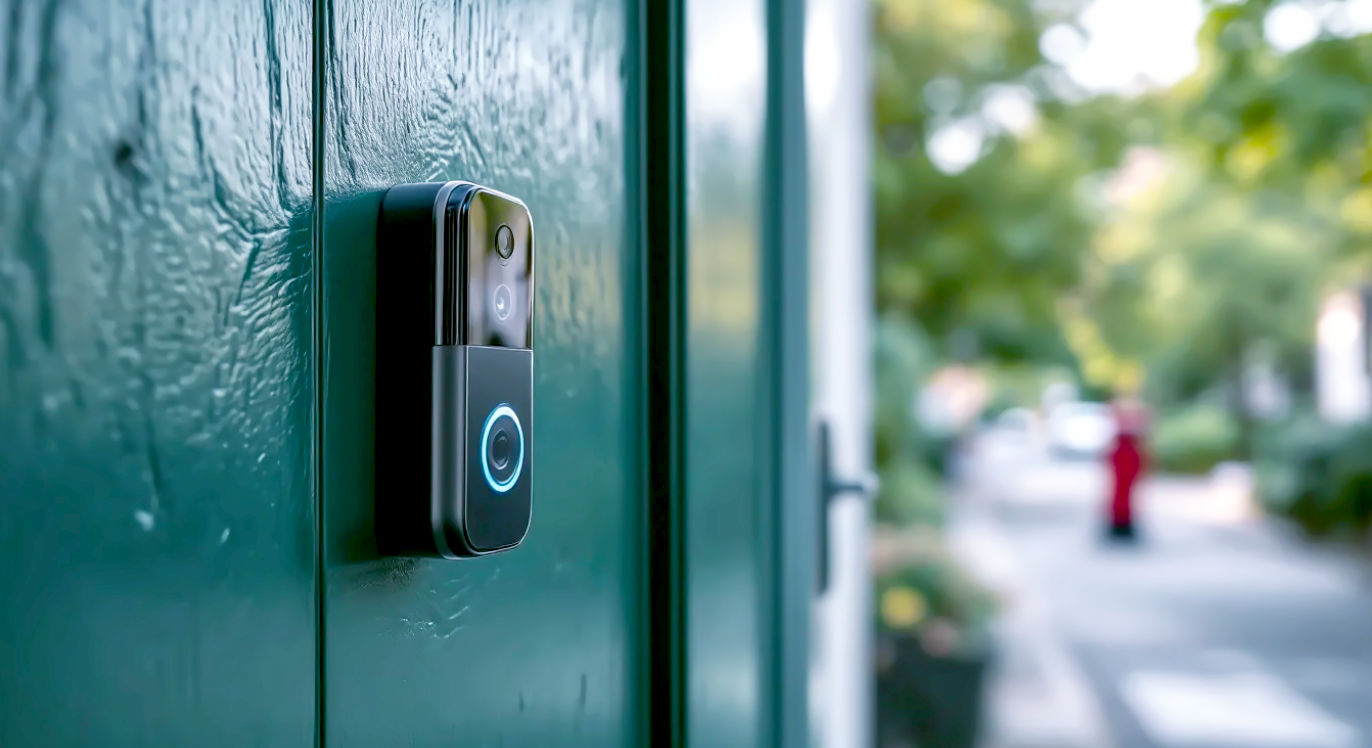The UK Guide to Smart Video Doorbells: Is This the Future of Home Security?
Everything a British homeowner needs to know about smart video doorbells, from installation and privacy rules to the best features and future trends.

This post may contain affiliate links. If you make a purchase through these links, we may earn a commission at no additional cost to you.
Ever wondered who’s at the door when you’re not home? Perhaps you’re tired of missing parcel deliveries or want a bit more peace of mind when you’re tucked up in bed. It turns out, the humble doorbell has had a massive upgrade, and it’s changing the way we think about keeping our homes safe.
Welcome to the world of the smart video doorbell. It’s more than just a button that chimes; it’s a clever bit of kit that acts like a digital gatekeeper for your front door. Think of it as a doorbell, a security camera, and an intercom all rolled into one nifty gadget. These devices connect to your home’s Wi-Fi and let you see and speak to visitors from your smartphone, whether you’re in the living room or on holiday in Spain.
In the UK, where we love our homes and our privacy, these gadgets are becoming incredibly popular. But they also bring up some big questions. Are they really making our neighbourhoods safer? What about our neighbours’ privacy? And are they worth the money?
This guide will walk you through everything you need to know. We’ll look at how they started, how they work, the rules you need to follow, and whether one is right for you. Let’s dive in and see what all the fuss is about.
What Exactly Is a Smart Video Doorbell?
At its heart, a smart video doorbell is a simple idea. It’s a doorbell with a built-in camera, microphone, and speaker. When someone presses the button, or when it detects movement, it sends an alert straight to your phone. You can then open an app to see a live video of who’s there and have a two-way conversation with them.
It’s like having a receptionist for your house who never takes a day off.
How It All Works: The Simple Tech Breakdown
You don’t need to be a tech genius to understand how these doorbells work. It’s all about connecting a few simple bits of technology together.
- The Camera: This is the doorbell’s eye. It records video, often in high definition (HD), so you can get a clear picture of what’s happening. Many have a wide-angle lens to show you a broad view of your doorstep and a bit of your garden or drive. They also have night vision, using infrared lights to see clearly even when it’s pitch black. So, you’ll be able to spot a hedgehog wandering across your path just as easily as the postie.
- The Motion Sensor: This is what makes the doorbell ‘smart’. It uses sensors to detect movement near your door. When someone walks up your path, the sensor triggers the camera to start recording and sends you a notification. You can usually adjust the sensitivity so it doesn’t go off every time a cat strolls by.
- The Wi-Fi Connection: This is the magic ingredient. The doorbell connects to your home’s Wi-Fi network to send video and alerts to your phone. It means you can be anywhere in the world with an internet connection and still answer your door.
- The App: This is your control centre. Every smart doorbell comes with a mobile app for your smartphone or tablet. From the app, you can view the live video feed, talk to visitors, watch recorded clips, and change the doorbell’s settings.
So, when a delivery driver rings the bell, you get a notification. You can open the app, say “Hello,” and ask them to leave the parcel in your designated safe spot. No more missed deliveries and no more little red cards from Royal Mail.
Battery-Powered vs. Hardwired: Which Is Right for You?
When you’re choosing a smart doorbell, one of the first decisions you’ll need to make is how to power it. You have two main options:
- Battery-Powered: These are the easiest to install. You just charge them up, screw the mounting bracket to your doorframe, and clip the doorbell in. The battery can last for a few months before it needs recharging. This is perfect if you’re renting or don’t fancy drilling holes and messing with wires. The downside is that you have to remember to charge it.
- Hardwired: These connect directly to your home’s existing doorbell wiring. This means you never have to worry about the battery running out. Installation is a bit more complicated, and you might need an electrician to help you out if you’re not confident with wiring. But once it’s done, it’s done.
There’s no right or wrong answer here; it just depends on your home and how comfortable you are with a bit of DIY.
The Journey of the Doorbell: From Mechanical Bells to Smart Tech
The idea of announcing your arrival at a door is as old as houses themselves. For centuries, people used their fists or a heavy door knocker. It wasn’t until the early 1800s that things got a bit more technical.
A Quick Trip Through Doorbell History
The first mechanical doorbell was invented by a Scottish inventor named William Murdoch in 1817. It was a system of pipes that made a loud noise when a button was pushed. It was clever, but it wasn’t until electricity became common in homes that the electric doorbell we know today was born.
In 1831, an American scientist named Joseph Henry created an electric buzzer. This was the start of the classic ‘ding-dong’ chime that echoed through British homes for decades. For over 150 years, not much changed. The doorbell was a simple circuit: press the button, the circuit closes, and a chime rings.
The Birth of the Smart Doorbell
The big leap forward came with the rise of smartphones and home Wi-Fi. In 2013, a small American company called Ring (originally named Doorbot) launched the first-ever smart video doorbell on a crowdfunding website. The idea was simple: what if you could answer your door from anywhere?
The founder, Jamie Siminoff, came up with the idea because he was frustrated with missing deliveries while tinkering in his garage. He wanted a way to see and speak to visitors without having to be right by the front door.
At first, people weren’t sure. But the idea quickly caught on. Homeowners loved the convenience and the extra layer of security. Big tech companies like Google (with its Nest brand) and Amazon (which eventually bought Ring in 2018 for a reported $1 billion) soon jumped on board.
Today, the smart doorbell market is massive, and these gadgets have become a common sight on front doors across the UK. They’ve moved from being a niche gadget for tech lovers to a mainstream home security tool.
The Smart Doorbell’s Impact on British Society
The rise of the smart doorbell isn’t just a story about technology; it’s also about how we live and how we see our communities. Here in the UK, it has sparked some interesting conversations.
A New Sense of Security or Neighbourhood Paranoia?
For many, a smart doorbell brings peace of mind. The idea is that would-be burglars will see the camera and think twice. Police forces in the UK have sometimes used footage from smart doorbells to help solve crimes, like identifying thieves who have been trying car doors or breaking into sheds.
Many smart doorbell apps also have a ‘neighbourhood’ feature, where users can share suspicious footage with others in their local area. On one hand, this can help people feel more connected and aware of what’s happening on their street. It can feel like a modern-day Neighbourhood Watch scheme.
However, some people worry it’s creating a culture of suspicion. Constantly getting alerts about people walking past your house can make you feel like you’re living in a high-crime area, even if you’re not. There’s a fine line between being vigilant and being paranoid. Seeing a video of a stranger on your path at 2 am is scary, but it could just be someone who has had a bit too much to drink and got the wrong house.
The Big Privacy Debate
This is the most significant issue surrounding smart doorbells in the UK. When your camera is recording, where does your property end and public space begin? What about your neighbour’s right to privacy?
Under UK law, you have rights, but you also have responsibilities. If your smart doorbell records footage outside the boundary of your property—for example, on the pavement, the street, or your neighbour’s garden—then data protection laws (like GDPR) apply.
This means you need to be careful. You should:
- Tell your neighbours: Let them know you have a camera and what it covers. A friendly chat can solve a lot of problems before they start.
- Use privacy zones: Most smart doorbell apps let you set up ‘privacy zones’. These are areas in the camera’s view that you can block out from being recorded, like a neighbour’s window or garden.
- Put up a sticker: A simple sticker saying that CCTV is in operation can help you meet your legal obligations. It lets people know they are being recorded before they step onto your property.
There have been court cases in the UK where homeowners have been sued by their neighbours for breaching their privacy with smart doorbell cameras. In one high-profile case, a judge ruled that a homeowner’s cameras were too intrusive and ordered him to pay damages. So, it’s something to take seriously. The Information Commissioner’s Office (ICO), which regulates data protection in the UK, has clear guidance on its website for anyone using domestic CCTV.
The key is to be a considerate user. Your security shouldn’t come at the cost of someone else’s privacy.
A Closer Look: Key Features to Consider
If you’re thinking about buying a smart doorbell, the number of options can be a bit overwhelming. Let’s break down the most important features to look for.
Video Quality and Field of View
The whole point of a video doorbell is to see who’s there, so video quality is crucial. Look for a doorbell that records in at least 1080p HD. This will give you a clear, sharp image. Some newer, more expensive models offer even higher resolutions, but 1080p is perfectly fine for most people.
The field of view is also important. This tells you how wide an angle the camera can see. A wider field of view means you’ll see more of your doorstep. Some doorbells now have a ‘head-to-toe’ view, which is useful for seeing parcels left on the ground.
Night Vision
Crime doesn’t just happen in the daytime. Good night vision is a must-have. Most smart doorbells use infrared LEDs to see in the dark. This produces a black-and-white image, but it’s usually very clear. Some pricier models offer colour night vision, which uses clever sensors and any available ambient light to produce a colour image, making it easier to identify things like the colour of someone’s coat.
Two-Way Talk
This is a standard feature on almost all smart doorbells, but the quality can vary. It allows you to speak to the person at your door through the app. This is great for instructing delivery drivers, telling salespeople you’re not interested, or even scaring off a potential intruder. Look for models with noise cancellation, as this will help you hear and be heard more clearly, especially if you live on a busy road.
Motion Detection and Customisable Zones
Smart motion detection is what separates a great doorbell from an annoying one. Basic motion detection will alert you to any movement, which can lead to a lot of false alarms.
Look for doorbells that offer customisable motion zones. This feature lets you draw boxes on the screen to select the specific areas you want to monitor, like your path or porch, while ignoring public areas like the pavement.
Some advanced models also have person detection. This means the doorbell can tell the difference between a person, an animal, and a vehicle. This is incredibly useful for reducing unwanted notifications. You only get an alert when it’s a person, which is usually what you care about.
Subscription Plans: What Do You Get for Your Money?
This is a big one. While you can use most smart doorbells out of the box for live viewing and notifications, many of the best features are locked behind a monthly subscription plan.
Typically, a subscription gives you access to cloud storage for your video recordings. This means that whenever the camera records a clip (either from a button press or motion), it’s uploaded and stored online for you to view later. Without a subscription, you might not be able to look back at past events at all.
These plans usually cost a few pounds a month. For example, Ring Protect starts at around £3.49 per month, while Google’s Nest Aware is about £5 per month. These plans often include extra features too, like person detection or extended warranties.
Before you buy a doorbell, make sure you check the subscription costs. It’s an ongoing expense you need to factor in. Some people are happy to pay for the extra features and storage, while others prefer a device with no monthly fees. A few brands offer local storage options (using an SD card), which is a good alternative if you want to avoid subscriptions.
Practical Tips for UK Homeowners
So, you’ve decided to get a smart doorbell. Here are a few tips to help you get the most out of it.
Choosing the Right Spot
Where you install your doorbell matters. You want it to have a clear view of the person approaching your door. The ideal height is usually about 4 feet (or 1.2 metres) from the ground. This is high enough to get a good view of a person’s face but low enough to see any parcels on the floor.
Think about the sun too. If your doorbell points directly into the rising or setting sun, you might get a lot of glare, which can make it hard to see anything.
Securing Your Smart Doorbell (and Your Wi-Fi)
These devices are connected to the internet, which means they can be a target for hackers. It’s important to make sure your digital security is as strong as your physical security.
- Use a strong, unique password for your doorbell’s app account. Don’t reuse the same password you use for other websites.
- Enable two-factor authentication (2FA) if it’s offered. This adds an extra layer of security by requiring a code from your phone, as well as your password, to log in.
- Keep your home Wi-Fi secure. Use a strong password for your Wi-Fi network and make sure you’re using WPA2 or WPA3 encryption (most modern routers do this automatically).
- Update the firmware. The manufacturer will release updates to patch security holes and add new features. Make sure you keep your doorbell’s software up to date.
Getting It Right with Your Neighbours
We’ve already touched on privacy, but it’s worth repeating. Being a good neighbour is key.
Before you install your doorbell, have a quick chat with the people next door. Explain that you’re getting it for security and that you’ll make sure it’s not pointing into their property. This simple conversation can prevent a lot of headaches later on.
Remember to use those privacy zones and put up a sticker. It shows you’re being responsible.
The Future of the Smart Doorbell
Smart doorbells are here to stay, and the technology is only going to get better. So, what can we expect to see in the future?
Smarter Detection with AI
Artificial intelligence (AI) is going to play a bigger role. Doorbells will get even better at understanding what they’re seeing. Imagine a doorbell that can not only tell you a person is there but can also recognise familiar faces. It could announce, “Auntie Carol is at the door,” through your smart speaker.
They might also be able to identify specific events. For example, they could recognise the sound of breaking glass and send you a special alert, or automatically call the emergency services. Package detection is already a feature on some models, where the doorbell specifically tells you when a parcel has been delivered and can even alert you if someone tries to take it.
Integration with the Rest of Your Smart Home
The smart doorbell will become an even more central part of the connected home. It already works with smart speakers like Amazon Alexa and Google Assistant, letting you see the doorbell’s video feed on a smart display.
In the future, we could see even tighter integration. For example, if your doorbell detects a person it doesn’t recognise while you’re out, it could automatically turn on the lights in your house to make it look like someone is home. Or, if it’s a trusted friend, it could automatically unlock the smart lock on your front door to let them in.
Beyond Security: New Uses for the Doorbell Camera
While security is the main focus now, the camera on our front door could be used for much more. It could help with things like:
- Monitoring health: For elderly relatives living alone, a smart doorbell could be used to check that they are okay. Family members could get an alert to confirm that a carer has arrived on time.
- Localised environmental data: A network of smart doorbells could collect data on local weather, air quality, or even noise pollution, providing a detailed picture of our towns and cities.
- Community science: They could be used to monitor local wildlife, like tracking the movements of birds or hedgehogs in suburban gardens.
The Final Verdict: Is a Smart Video Doorbell a Good Idea for You?
So, after all that, should you buy one? Like most technology, it comes down to your personal needs and circumstances.
A smart video doorbell is probably a great idea if:
- You get a lot of parcels delivered and are often out.
- You want an extra layer of security and the peace of mind that comes with it.
- You are comfortable with the technology and happy to manage the privacy settings responsibly.
- You are prepared to pay a monthly subscription for the best features.
You might want to think twice if:
- You have serious concerns about privacy (both your own and your neighbours’).
- You live in a flat with a shared entrance, as it can be complicated to install and may not be allowed.
- You’re on a tight budget and don’t want to be tied into another monthly subscription.
- You’re not comfortable with smart technology and prefer a simpler approach to home security.
The smart video doorbell has fundamentally changed our relationship with our front door. It has transformed a simple button into a powerful security and convenience tool. It offers a window to our doorstep from anywhere in the world, giving us more control and awareness than ever before.
But it also reminds us that with new technology comes new responsibilities. As these clever little cameras become a more common feature of the British streetscape, it’s up to all of us to use them thoughtfully, respecting the privacy of those around us.
The future of home security is here. It’s smart, it’s connected, and it starts with the simple act of ringing a bell.
Further Reading
For those interested in exploring the topic further, here are some highly respected UK-based resources:
- Which? – Provides independent and rigorous reviews of smart doorbells and home security systems.
- Information Commissioner’s Office (ICO) – Offers official guidance on the legal responsibilities of using domestic CCTV and video doorbells in the UK.
- Neighbourhood Watch Network – A charity that works with police and communities to prevent crime, offering advice on home security.
- Secured by Design – The official police security initiative that provides a recognised standard for security products, including smart doorbells.






